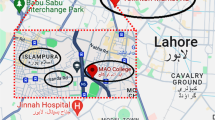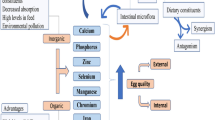Abstract
Three hundred and sixty healthy Ross × Ross 1-day-old broilers were used to study the effects of zinc glycine chelate (Zn-Gly) on oxidative stress, contents of trace elements, and intestinal morphology. All broilers were randomly assigned to six treatment groups, which replicates three times. Diets were as follows: (1) control (containing 29.3 mg zinc (Zn)/kg basic diet (0–21 days) and 27.8 mg Zn/kg (22–42 days)); (2) basic diet plus 30 mg Zn/kg from Zn-Gly; (3) basic diet plus 60 mg Zn/kg from Zn-Gly; (4) basic diet plus 90 mg Zn/kg from Zn-Gly; (5) basic diet plus 120 mg Zn/kg from Zn-Gly; and (6) positive control, basic diet plus 120 mg Zn/kg from zinc sulfate (ZnSO4). The results showed that the addition of 90 or 120 mg/kg Zn-Gly led to an improvement of activity of Cu/Zn superoxide dismutase and glutathione peroxidase and a reduction of malondialdehyde content in livers at 21 and 42 days. With 90 mg/kg Zn-Gly, the content of sera zinc increased by 17.55% (P < 0.05) in 21-day broilers and 10.77% (P > 0.05) in 42-day broilers compared with that of the control. Adding 120 mg/kg Zn-Gly or ZnSO4 to broilers' diets greatly enhanced the content of zinc in feces at 21 days (P < 0.05) and at 42 days (P < 0.05). For 42-day chickens, increased villus height and decreased crypt depth of the jejunum could be observed in the second growth stage of broilers fed with 90 mg/kg Zn-Gly. Also, intestinal wall thickness decreased (P < 0.05). In addition, adding 90 mg/kg Zn-Gly to the diet markedly elevated villus length of duodenum and decreased crypt depth of ileum (P < 0.05) in 42-day broilers.


Similar content being viewed by others
References
Brandao-Neto J, Stefan V, Mendonca BB et al (1995) The essential role of zinc in growth. Nutr Res 15:335–358
Powell SR (2000) The antioxidant properties of zinc. J Nutr 130:S1447–S1454
Prasad AS (2004) Antioxidant effect of zinc in human. Free Radic Biol Med 37:1182–1190
Sahin K, Smith MO, Onderci M et al (2005) Supplementation of zinc from organic or inorganic source improves performance and antioxidant status of heat-distressed quail. Poultry Sci 84:882–887
Li BT, Van Kessel AG, Caine WR et al (2001) Small intestinal morphology and bacterial populations in ileal digesta and feces of newly weaned pigs receiving a high dietary level of zinc oxide. Can J Anim Sci 81:511–516
Payne RL, Bidner TD, Fakker TM et al (2006) Growth and intestinal morphology of pigs from sows fed two zinc sources during gestation and lactation. J Anim Sci 84:2141–2149
Sahin K, Omer K (2003) Zinc supplementation alleviates heat stress in laying Japanse quail. J Nutr 133:2808–2811
Poulsen HD, Larsen T (1995) Zinc excretion and retention in growing pigs fed increasing levels of zinc oxide. Livest Prod Sci 43:235–242
Case CL, Carlson MS (2002) Effect of feeding organic and inorganic sources of additional zinc on growth performance and zinc balance in nursery pigs. J Anim Sci 80:1917–1924
Carlson MS, Boren CA, Wu C et al (2004) Evaluation of various inclusion rates of organic zinc either as a polysaccharide or proteinate complex on the growth performance, plasma, and excretion of nursery pigs. J Anim Sci 82:1359–1366
Meyer TA, Lindemann MD, Cromwell GL et al (2002) Effects of pharmacological levels of zinc as zinc oxide on fecal zinc and mineral excretion in weanling pigs. Prof Anim Sci 18:162–168
Takkar PN, Mann MS (1978) Toxic levels of soil and plant zinc for maize and wheat. Plant Soil 49:667–669
Wedekind KJ, Hortin AE, Baker DH (1992) Methodology for assessing zinc bioavailability: efficacy estimates for zinc-methionine, zinc sulfate, and zinc oxide. J Anim Sci 70:178–187
Wedekind KJ, Lewis AJ, Giesemann MA et al (1994) Bioavailability of zinc from inorganic and organic sources for pigs fed corn–soybean meal diets. J Anim Sci 72:2681–2689
Caq J, Henry PR, Davis SR et al (2002) Relative bioavailability of organic zinc sources based on tissue zinc and metallothionein in chicks fed conventional dietary zinc concentration. Anim Feed Sci Technol 101:161–170
Van Heugten E, Spears JW, Kegley EB et al (2003) Effects of organic forms of zinc on growth performance, tissure zinc distribution, and immune response of weanling pigs. J Anim Sci 81:2063–207l
Feng J, Ma WQ, Niu HH et al (2009) Effects of zinc glycine chelate on growth, hematological, and immunological characteristics in broilers. Biol Trace Elem Res 133:203–211
NRC (1994) Nutrientional requirements of poultry, 9th edn. National Academy, Washington DC
Hill GM, Link JE, Meyer L et al (1999) Effect of vitamin E and selenium on iron utilization in neonatal pigs. J Anim Sci 77:1762–1768
Claiborne A (1985) In: Robert AG (ed) Handbook of methods for oxygen radical reaserch. CRC, Boca Rato, pp 213–215
Rotruck JT, Pope AL, Ganther HE et al (1973) Selenium: biochemical role as a component of glutathione peroxidase. Science 179:588–590
Esterbauer H, Cheeseman KH (1990) Determination of aldehydic lipid peroxidation products: malonaldehyde and 4-hydroxynonenal. Meth Enzymol 186:407–421
Satoh K (1978) Serum lipid peroxide in cerebrovascular disorders determined by a new colorimetric method. Clin Chim Acta 90:37–43
Armstrong TA, Cook DR, Ward MM et al (2004) Effect of dietary copper source (cupric citrate and cupric sulfate) and concentration on growth performance and fecal copper excretion in weanling pigs. J Anim Sci 82:1234–1240
Hill GM, Miller ER, Whetter PA et al (1983) Concentration of minerals in tissues of pigs from dams fed different levels of dietary zinc. J Anim Sci 57:130–138
Carson FL (1997) Histotechnology: a self-instructional text, 2nd edn. ASCP, Chicago
SAS Institute Inc (1996) Statistical analytical system user’s guide. Version 6.12 edition. SAS Institute Inc, Cary
Osaretin ATE, Gabriel A (2008) Akande. Effect of zinc deficiency on memory, oxidative stress and blood chemistry in rats. Adv Med Dent Sci 2:74–82
Canada AT, Calabrese EJ (1989) Superoxide dismutase: its role xenobiotic detoxification. Pharmacol Ther 44:285–295
Farombi EO, Hansen M, Raven-Haren G et al (2004) Commonly consumed and naturally occurring dietary substances affect biomarkers of oxidative stress and DNA damage in the healthy rats. Food Chem Toxicol 2:15–22
Venkataraman P, Sridhar M, Dhanammal S et al (2004) Antioxidant role of zinc in PCB (Aroclor 1254) exposed ventral prostate of albino rats. J Nutr Biochem 15:608–613
Kato J, Ruram AA, Singh SS et al (2007) Lipid peroxidation and antioxidant vitamins in urolithasis. Indian J Clin Biochem 22:128–130
Ozturk A, Baltaci AK, Mogulkoc R et al (2003) Effects of zinc deficiency and supplementation on malondialdehyde and glutathione levels in blood and tissue of rats’ performance swimming exercise. Biol Trace Elem Res 94:157–166
Sihdu P, Garg ML, Dhawan DK (2004) Protective effects of zinc on oxidative stress enzymes in liver of protein deficient rats. Nutr Hosp 19:341–347
Shaheen AA, el-Fattah AA (1995) Effect of dietary zinc on lipid peroxidation, glutathione, protein thiols leves and superoxide dismutase activity in tissues. Int J Biochem Cell Biol 27:89–95
Buzadzic B, Korac B, Lazic T et al (2002) Effects of supplementation with Cu and Zn on antioxidant enzyme activity in the rat tissues. Food Res Int 35:217–220
Pathak A, Mahmood A, Pathak R et al (2002) Effect of zinc on hepatic lipid peroxidation and antioxidative enzymes in ethanol-fed rats. J Appl Toxicol 22:207–210
Bray TM, Bettger WJ (1990) The physiological role of zinc as an antioxidant. Free Radical Biol Med 8:281–291
Coudray C, Richard MJ, Laporte F et al (1992) Superoxide dismutase activity and zinc status: a study in man and animals. J Nutr Med 3:13–26
Ohly P, Dohle C, Abel J et al (2000) Zinc sulphate induces metallothonein in pancreatic islets of mice and prediabetes induced by multiple low doses of streptozotocin. Diabetologia 43:1020–1030
Taylor CG, McCutchon TL, Boermans HJ et al (1997) Comparison of Zn and vitamin E for protection against hyperoxia induced lung damage. Free Radic Biol Med 22:543–550
Hill CH, Matrone G (1970) Chemical parameters in the study of in vivo and in vitro interactions of transition elements. Fed Proc 29:1474–1481
Sundaresan PR, Kaup SM, Wiesenfeld PW et al (1996) Interactions in indices of vitamin A, zinc and copper status when these nutrients are fed to rats at adequate and increased levels. Brit J Nutr 75:915–928
Schell TC, Kornegay ET (1996) Zinc concentration in tissues and performance of weanling pigs fed pharmacological levels of zinc from ZnO, Zn-methionine, Zn-lysine, or ZnSO4. J Anim Sci 74:1584–1593
Katouli M, Melin L, Jensen-Waern M et al (1999) The effect of zinc oxide supplementation on the stability of the intestinal flora with special reference to composition of coliforms in weaned pigs. J Appl Microbiol 87:564–573
HØjberg O, Canibe N, Poulsen HD et al (2005) Influence of dietary zinc oxide and copper sulfate on the gastrointestinal ecosystem in newly weaned piglets. Appl Environ Microbiol 71:2267–2277
Southon S, Gee JM, Bayliss GE et al (1986) Intestinal microflora, morphology and enzyme activity in zinc-deficient and Zn-supplemented rats. Br J Nutr 55:603–611
Caine W, McFall M, Miller B, et al. 2001 Intestinal development of pigs from sows fed a zinc amino acid complex. Advances in Pork Production. 12: Abstract (No.15) Proc. Banff Pork Seminar, Banff, Alberta, Canada
Metzler-Zebeli BU, Caine WR, McFall M et al (2010) Supplementation of diets for lactating sows with zinc amino acid complex and gastric nutriment-intubation of suckling pigs with zinc methionine on mineral status, intestinal morphology and bacterial translocation in lipopolysaccharide-challenged weaned pigs. J Anim Physiol Anim Nutr 94:237–249
Castillo M, Martín-Orue SM, Taylor-Pickard JA et al (2008) Use of mannanoligosaccharides and zinc chelate as growth promoters and diarrhea preventative in weaning pigs: effects on microbiota and gut function. J Anim Sci 86:94–101
Tako E, Ferket PR, Uni Z (2005) Changes in chicken intestinal zinc exporter mRNA expression and small intestinal functionality following intra-amniotic zinc-methionine administration. J Nutr Biochem 16:339–346
Acknowledgements
This work was supported by Grant Agreement 2004CB117506, a Key Science Project“973” Award from National Science and Technology Committee, and by Grant Agreement 2009C02007-2, a Key Science Project Award from Zhejiang province Science and Technology Committee, People's Republic of China. The authors would like to thank the Weifeng Bio.Corporation, China, for providing food grade zinc glycine chelate for this research.
Author information
Authors and Affiliations
Corresponding author
Rights and permissions
About this article
Cite this article
Ma, W., Niu, H., Feng, J. et al. Effects of Zinc Glycine Chelate on Oxidative Stress, Contents of Trace Elements, and Intestinal Morphology in Broilers. Biol Trace Elem Res 142, 546–556 (2011). https://doi.org/10.1007/s12011-010-8824-9
Received:
Accepted:
Published:
Issue Date:
DOI: https://doi.org/10.1007/s12011-010-8824-9




